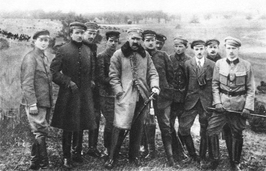Polish Military Organisation
| Polish Military Organisation | |
|---|---|
| Polska Organizacja Wojskowa (POW) | |
Michał Żymierski Tadeusz Kasprzycki | |
| Insignia | |
| Emblem of the Polish Military Organisation | Logo of Związek Peowiaków.JPG |

The Polish Military Organisation, PMO (
History
Intelligence and training
The Polish Military Organization (PMO) can be traced to formations of August 1914 or even earlier, but it was officially founded in November 1914 as a merger of two previously existing youth para-military organisations: the
Initially active only in Central Poland, the PMO units in time were formed in all parts of the former Polish–Lithuanian Commonwealth, including what is now Lithuania, Belarus, Ukraine and Russia. It was mainly preoccupied with intelligence and sabotage, as well as military training of its members and the acquisition of arms from various armies fighting on Polish soil. The PMO members were seen as the core of the future Polish Army after Poland had regained its independence.
After most of Poland was occupied by the Central Powers in 1915, the PMO became semilegal and unofficially supported by the German army, which saw it as a useful source of information on Russia and a useful reservoir of skilled officers. However, in July 1917, after the
Sabotage and open fight

With the collapse of the Central Powers during the final stages of the war, the PMO command decided to take an active part in the war and went out into the open. In October and November 1918, the revolutions in Germany and Austria-Hungary made the Ober Ost army collapse. The German units were struck by mass desertions of soldiers, who simply left their posts and headed for their homes.
The main tasks of the PMO was then to disarm the withdrawing soldiers and to escort them to Germany. The campaign was successful and gave the newly born Polish state a large quantity of arms and military equipment. By mid-November, most of garrisons in
Later struggles
Contrary to the rest of units, the PMO in Ukraine (most notably, the areas controlled by the Western Ukrainian government and or the
in July 1920.In February 1918, a similar organisation was formed in the
In February 1919, the
In Lithuania
In Lithuania, the PMO was organizing a
From the documents that were stolen in its headquarters safe in Vilnius and given to Prime Minister of Lithuania Augustinas Voldemaras, it is clear that the plot had been directed by Piłsudski himself.[3] A PMO-led uprising occurred in the Sejny region, which was controlled by Lithuanian forces, and led to Polish forces gaining control of that disputed territory.
Influence in Soviet Union
Although the PMO was disbanded in 1921, Soviet authorities claimed that it continued to exist. During the Great Purge from 1936 to 1938[4] and as early as 1933,[5] many people of Polish nationality were charged with membership in it, which was illegal. See Polish Operation of the NKVD for the circumstances and NKVD Order No. 00485 in particular.
Commanders
- from August 1914 K. Rybasiewicz,
- from October 1914 ppor. Tadeusz Żuliński,
- from August 1915 mjr Michał Żymierski,
- from October 1915 mjr Tadeusz Kasprzycki
References
- ^ Juozas, Rainys (1936). P.O.W. : (Polska Organizacja Wojskowa) Lietuvoje. Kaunas: Spaudos fondas. p. 184.
- ISBN 9986-413-31-1.
- ISBN 9955-423-23-4.
- ISBN 0-300-10851-6), p. 417.
- ISBN 0-8014-8677-7), p. 328.
